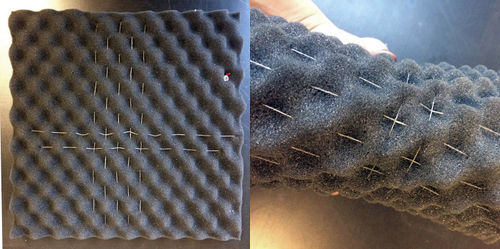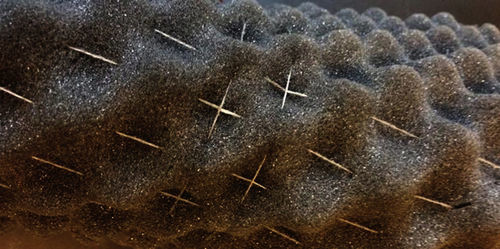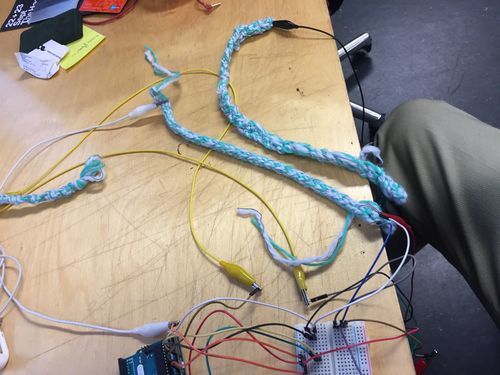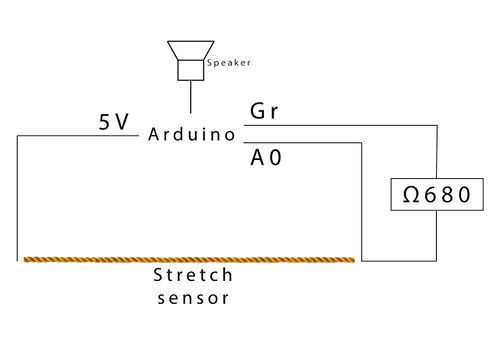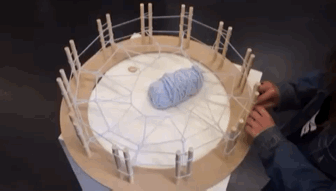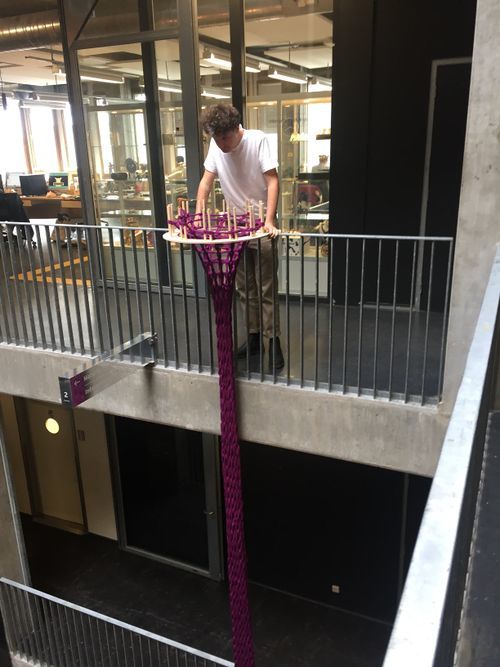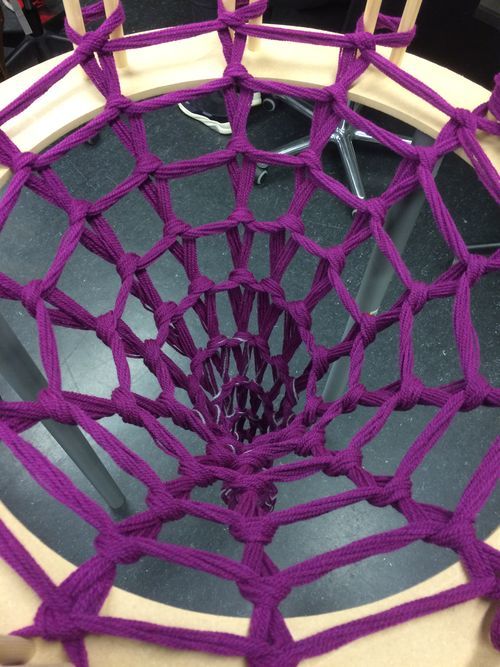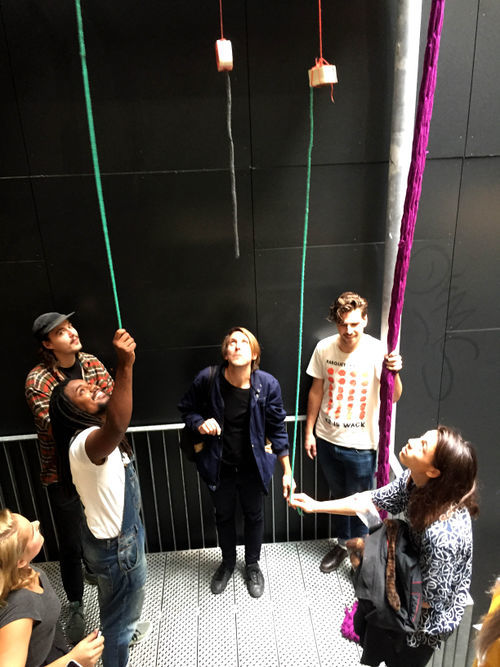Difference between revisions of "User:Jeanine Verloop/minor sensor"
(→links) |
|||
| (19 intermediate revisions by 2 users not shown) | |||
| Line 18: | Line 18: | ||
THARIM CORNELISSE<br> | THARIM CORNELISSE<br> | ||
Major // illustration <br> | Major // illustration <br> | ||
| − | [[User: | + | [[User:Tharim | PAGE THARIM]]<br> |
JEANINE VERLOOP<br> | JEANINE VERLOOP<br> | ||
Major // illustration <br> | Major // illustration <br> | ||
| − | [[User: | + | [[User:Jeanine | PAGE JEANINE]]<br> |
== STARTING POINT == | == STARTING POINT == | ||
| Line 33: | Line 33: | ||
== DEVELOPMENT == | == DEVELOPMENT == | ||
| + | <span style='width:40em;display:block;'> | ||
| + | We picked vera's way of making conductive material, French knitting with wool and conductive thread. To make this work we attached the cord to the arduino. One end would be attached to the 5v pin of the arduino and the other side would be connected to the A0 pin and the ground pin. In between the ground pin and the cord we placed a 680 Ω resistor. The cord is now acting as a potmeter. When you pull the cord the resistance of the cord becomes smaller. The arduino measures the difference in voltage of the A0 pin and the ground pin and it translates this to serial data. | ||
| + | <br/><br/> | ||
| + | We programmed the arduino so that it translated the serial data to frequencies. For example, when the cord is in resting position the arduino monitor would read 520 and when we pull the string it would read 960. We would map the arduino to output a frequency of 0hz when it reads 520 and 1000hz when it reads 960. | ||
| + | <br/><br/> | ||
| + | The serial data received from the arduino could be used in many ways. We also experimented with other sounds and samples by connecting the serial port (where the arduino was attached to) to Ableton live. The sensor could trigger all sorts of instruments, effects, and automation. We didn’t use this way of working in the end because you always had to be near a computer to use the sensor. | ||
| + | <br/><br/></span> | ||
| + | [[File:WIP-Tharim3.png|500px]] | ||
| + | |||
| + | [[File:WIP-Tharim.jpg|500px]] | ||
| + | |||
| + | [[File:Stretch_sensor.jpg|500px]] | ||
| + | |||
| + | === Making our own French knitting tool === | ||
| + | |||
[[File:Minor sensor tharim vera jeanine 2.GIF|500px]] | [[File:Minor sensor tharim vera jeanine 2.GIF|500px]] | ||
| Line 39: | Line 54: | ||
[[File:Minor sensor tharim vera jeanine 1.jpg|500px]] | [[File:Minor sensor tharim vera jeanine 1.jpg|500px]] | ||
| − | + | == PRESENTATION == | |
| − | + | <span style='width:40em;display:block;'> | |
| − | + | For our presentation, we wanted to connect the result of pulling the string to the action that was needed to pull the string. The group of third-year students had made some videos that inspired us. In their video, they exaggerated the movement the body makes while stretching. | |
| − | + | <br/><br/> | |
| − | + | It gets interesting when you can make people do stuff without necessary commanding them to. We wanted to make people stretch without them being aware that that was our purpose. To achieve this we placed several chords on different heights in the staircase. By curiosity or simply because they were confronted with a strange object in the -semi-public space people would pull or touch -accidentally- the cord. When noticing there was a sound coming out of it, they would reach higher and higher for the other cords. | |
| − | + | <br/><br/> | |
| + | You could say that in the end the artifact was not only the cord, but the people stretching to pull the cord. | ||
| + | <br/><br/></span> | ||
[[File:RESULT-Tharim.jpg|500px]] | [[File:RESULT-Tharim.jpg|500px]] | ||
== NEXT == | == NEXT == | ||
| − | + | <span style='width:40em;display:block;'> | |
| + | On numerous occasions, we discussed how we could place this cord in our everyday life. The cord is strange, yet pulling it and hearing the sound feels so familiar and normal at the same time. We wanted to give this cord in some way a place in daily life. | ||
| + | <br/><br/> | ||
| + | Inspiration for exeqution was the well known movie: The Phantom of Liberty | ||
| + | </span> | ||
| + | |||
| + | [[File:Minor sensor tharim vera jeanine phantom of liberty.jpg|500px]] | ||
| + | |||
| + | |||
| + | |||
| + | |||
| + | <span style='width:10em;font-size:40px;color:black;background:#2fffee;'>[[https://vimeo.com/240474524 WATCH VIDEO ~ waking up]]</span> | ||
| + | |||
| + | |||
| + | |||
| + | <span style='width:10em;font-size:40px;color:black;background:#2fffee; '>[[https://vimeo.com/240474349 WATCH VIDEO ~ travelling]]</span> | ||
| + | |||
| + | |||
| + | |||
| + | <span style='width:10em;font-size:40px;color:black;background:#2fffee;;'>[[https://vimeo.com/240474616 WATCH VIDEO ~ working]]</span> | ||
== links == | == links == | ||
</center> | </center> | ||
| + | <span style='width:40em;display:block;'> | ||
| + | [https://www.youtube.com/watch?v=Nvd7wRL0OBs| Using serial data from the Arduino to control Ableton] | ||
Latest revision as of 08:54, 2 November 2017
behavioural stretching
Contents
PEOPLE
VERA CASTELIJNS
Major // graphic design
PAGE VERA
THARIM CORNELISSE
Major // illustration
PAGE THARIM
JEANINE VERLOOP
Major // illustration
PAGE JEANINE
STARTING POINT
DEVELOPMENT
We picked vera's way of making conductive material, French knitting with wool and conductive thread. To make this work we attached the cord to the arduino. One end would be attached to the 5v pin of the arduino and the other side would be connected to the A0 pin and the ground pin. In between the ground pin and the cord we placed a 680 Ω resistor. The cord is now acting as a potmeter. When you pull the cord the resistance of the cord becomes smaller. The arduino measures the difference in voltage of the A0 pin and the ground pin and it translates this to serial data.
We programmed the arduino so that it translated the serial data to frequencies. For example, when the cord is in resting position the arduino monitor would read 520 and when we pull the string it would read 960. We would map the arduino to output a frequency of 0hz when it reads 520 and 1000hz when it reads 960.
The serial data received from the arduino could be used in many ways. We also experimented with other sounds and samples by connecting the serial port (where the arduino was attached to) to Ableton live. The sensor could trigger all sorts of instruments, effects, and automation. We didn’t use this way of working in the end because you always had to be near a computer to use the sensor.
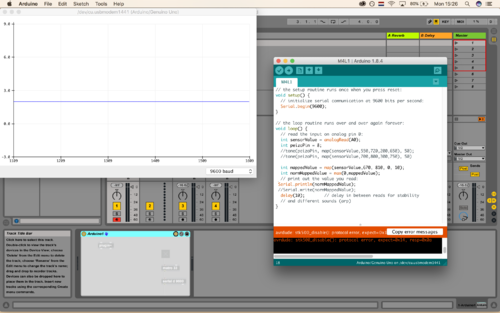
Making our own French knitting tool
PRESENTATION
For our presentation, we wanted to connect the result of pulling the string to the action that was needed to pull the string. The group of third-year students had made some videos that inspired us. In their video, they exaggerated the movement the body makes while stretching.
It gets interesting when you can make people do stuff without necessary commanding them to. We wanted to make people stretch without them being aware that that was our purpose. To achieve this we placed several chords on different heights in the staircase. By curiosity or simply because they were confronted with a strange object in the -semi-public space people would pull or touch -accidentally- the cord. When noticing there was a sound coming out of it, they would reach higher and higher for the other cords.
You could say that in the end the artifact was not only the cord, but the people stretching to pull the cord.
NEXT
On numerous occasions, we discussed how we could place this cord in our everyday life. The cord is strange, yet pulling it and hearing the sound feels so familiar and normal at the same time. We wanted to give this cord in some way a place in daily life.
Inspiration for exeqution was the well known movie: The Phantom of Liberty
